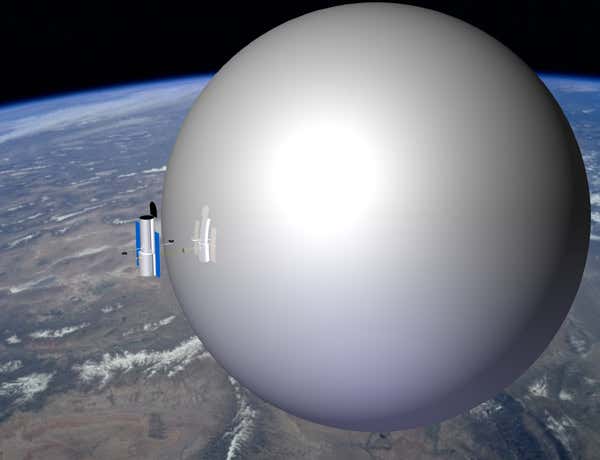Estou a fazer com meus colegas de escola um projeto para ajudar a limpar o lixo espacial. Numa das nossas pesquisas econtramos um artigo onde engenheiros da Global Aerospace Corporation (Altadena, Califórnia) afirmam que a utilização de balões de hélio gigantes poderá ser a forma mais barata de resolver o problema do lixo espacial. O problema é que não conseguimos entender como é que o balão irá conseguir trazer o satélite para a nossa atmosfera.
Um satélite em órbita dispõe de algum combustível para ir fazendo pequenas correções por forma a manter a órbita estável. Quando esse combustível é totalmente consumido, o satélite deixa de estar operacional passando a constituir parte do lixo espacial. Nesta fase não temos controlo sobre o satélite pelo que este constitui um risco para os demais equipamentos presentes em órbita. Com o passar do tempo a resistência do ar fará com que o satélite vá caindo aos poucos. Contudo este é um processo muito lento (levaria vários séculos) pois a altitudes da ordem dos 1000km a atmosfera é muito ténue, o que faz com que a resistência do ar seja muito pequena. À medida que vai caindo a resistência do ar vai aumentando até que quando o satélite estiver suficientemente baixo a resistência do ar será tanta que este acaba por arder na nossa atmosfera.
Para que este processo não demore séculos podemos pensar em providenciar ao satélite uma reserva de combustível (para utilizar apenas nesta fase final) capaz de levar rapidamente o satélite para uma órbita mais baixa onde se desintegrará.
A outra solução apresentada no referido artigo é a de levar um balão gigante (36m de diâmetro) acondicionado no satélite. Quando o satélite deixar de estar operacional este balão irá encher-se de gás aumentando consideravelemente a área do satélite. Embora a resistência do ar seja, como já foi dito, bastante baixa, o seu efeito será agora mais sentido uma vez que estará a atuar sobre uma área MUITO maior, o que fará reduzir em muito o tempo de queda do satélite para uma órbita mais baixa. Antes eram necessários séculos, agora basta (segundo o referido artigo) apenas um ano. Quando o satélite estiver suficientemente baixo a resistência do ar será tanta que este acaba por arder (juntamente com o balão) na nossa atmosfera.
I'm doing a project with my schoolmates to help clean up space junk. In one of our searches, we found an article where engineers from the Global Aerospace Corporation (Altadena, California) stated that the use of giant helium balloons could be the cheapest way to solve the problem of space debris. The problem is that we can't understand how the balloon will manage to bring satellites into our atmosphere.
A satellite in orbit has some fuel to make small corrections, to keep the orbit stable. When this fuel is completely consumed, the satellite ceases to be operational and becomes part of space junk. At this stage, we have no control over the satellite, which means that it poses a risk to other equipment in orbit. Over time, air resistance will cause the satellite to fall slowly. However, this is a very slow process. It would take several centuries to occur, because at altitudes of around 1 000 km, the atmosphere is very rare, which means that air resistance is small. As it falls, air resistance increases, until, when the satellite is low enough, the air resistance will be so great that it burns up in our atmosphere.
So that this process doesn't take centuries, we can think of providing the satellite with a fuel reserve, to be used only in this final phase, capable of quickly taking the satellite to a lower orbit, where it will disintegrate.
The other solution presented in that article is to take a giant balloon (36m in diameter) packed in the satellite. When the satellite ceases to be operational, this balloon will fill with gas, considerably increasing the area of the satellite. Although the air resistance is, as already mentioned, quite low, its effect will now be bigger, since it will be acting over a MUCH larger area, which will greatly reduce the time for the satellite to fall to a lower orbit. low. Before, centuries were needed, now, according to the referred article, a single year is enough. When the satellite is low enough, the air resistance will be such that it ends up burning (along with the balloon) in our atmosphere.

Illustrated image: Global Aerospace Corporation/NASA
[https://www.newscientist.com/article/dn19262-giant-balloons-could-clear-out-space-junk/]

